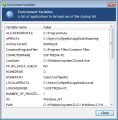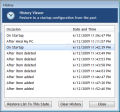Although you spend a lot of money on hardware components (RAM, CPU or mainboard) to make your system faster and easier to work with, the results do not always depend on these investments. I am not arguing with the fact that an operating system that runs on 2GHz dual-CPU with 2GB RAM is a lot faster than one running under a 2GHz CPU with 512 RAM, but sometimes the differences are in the way Windows is customized to operate. And here I’m referring to the number of programs that run in startup, the applications that we start and which require a lot of memory usage and “eat” up system resources.
The smaller the number of apps in startup, the faster your Windows will boot. And let’s say you cannot simplify this list; in this case at least add a delay after each application starts, or create an order for the items to start. This way, CPU and memory usage is redirected to both programs and your operating system, rather than only to the former.
InControl was designed to be a startup manager that will allow users to control the number of applications that are starting every time Windows starts. The basic operations that a startup manager must support are adding or removing entries, as well as disabling or enabling them. Besides the basic features, InControl offers additional options, such as sorting and filtering items by user, blacklisting items or viewing the management history. The program comes with a 30-day trial period and no other limitation except for an annoying nag screen. To register the software you need to pay $29.95, which I think is a lot for what InControl can do.
The main window of InControl is also the control board. You can see a list with all the startup items and choose to disable or remove the ones you consider to be suspicious or you don’t want in startup. Adding a new item is easy, since the designated window lets you select the start location, which I consider to be an important option.
The first test that I made was using the Winamp program, which asks you for startup entry permission. InControl does not block or warn you about any modification to the startup list but it provides another method. From the Special tab you can register InControl to startup, while running it creates a system tray icon from where it can be called. If a new item is detected in startup InControl will automatically index and list the application in the main window. It is not the perfect method but it can be useful if you suspect a program of creating startup items (related or non-related to its functionality).
In addition to this feature InControl will also allow you to blacklist an application. If you find a suspicious item that creates a startup entry and you want to permanently block it, add it to the so-called “black list.” Every event is recorded in a list from where you can restore it to a previous startup configuration. The list is available through History Viewer.
The problem with this window is that it displays only the Occasion or moment (e.g. On Startup, After item deleted) and Date and Time. It is useful if you delete an entry by mistake, since you can immediately restore it, but if you want to restore the list to a previous event, the details are irrelevant. To overcome this, InControl lets you export the list, so it is wise to do that if any major changes were made (import function is also available). For every item that is in startup InControl displays a few details like: Vendor, Location, Description or Used Memory, but more information can be found using the “Search in Google” option.
The User Interface provides additional options besides startup management. From the Tools menu you can access Disk Space Cleanup, System Information, Add/Remove Programs, UpTime or Heal My PC. The last one opens a small tweak window with three options to choose from: Clean-up Non-Working Startup Items, Fix Application Paths and Remove Broken Uninstallers. In the main window InControl lets you sort and filter the items upon Name, Vendor or Memory Usage. Another way to sort the items upon current user or all users is Category Tree.
The Good
The Bad
The Truth
Here some snapshots of the application in action:
 14 DAY TRIAL //
14 DAY TRIAL // 















